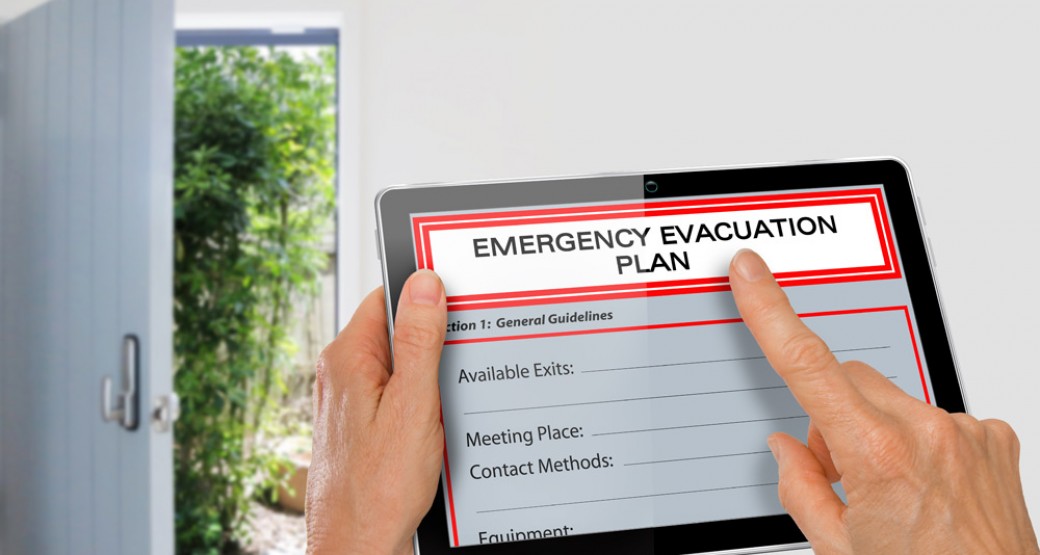Disaster can strike at any time, even if we do everything we can to keep our home and family safe. We never know when a fire, carbon monoxide leak, or natural disaster may render our homes unsafe. Having a complete home security system and keeping your home well-maintained can do a lot to prevent potential problems, but unexpected emergencies can still happen. In addition to taking precautions to avoid preventable disasters, it’s important to know how to make an evacuation plan.
Why Do I Need An Evacuation Plan?
Under normal circumstances, your evacuation plan may seem obvious. “If there’s a fire, we’ll all just go out the front door. If we can’t go that way, we’ll go out the back or through the side. There are plenty of exits.”
In the midst of a life-threatening emergency, however, fear and confusion can create havoc when there’s no clear plan in place. Thick, choking smoke can prevent people from being able to navigate through a home easily. The roar and destruction of a tornado can cause chaos as people scramble to get to safety. In the midst of the emergency, it may be unclear if elderly family members, toddlers or pets have been able to safely find a way out.
When it comes to disasters, preparedness is key. That’s why you need to learn how to make an evacuation plan and have your family practice it and commit it to memory.
How to Make an Evacuation Plan
It’s hard to know where to start when planning for something as stressful as an emergency evacuation. Use these tips as a guide to layout your evacuation plan.
Be Seen
Make sure your house number is clearly visible from the road. This is critical to rescue personnel who may need to find your house in the event of an emergency. If it’s not visible, install easy-to-see house numbers or paint it on the curb in front of your home.
Customize Your Plans
Consider the kinds of emergencies that are likely to happen where you live and plan accordingly. All homes are subject to fires and carbon monoxide leaks. Certain geographic regions are prone to natural disasters such as earthquakes and tornadoes. Make an evacuation plan that’s appropriate for each kind of disaster. While everyone should move safely away from the house if there is a fire, a tornado will have everyone gathering in a storm cellar or breaking off to hide in certain bathrooms or closets. Make plans that are specific to each type of emergency you are likely to encounter.
Assign Responsibilities
Identify who is responsible for what. The first consideration, of course, is saving human life and getting everyone out safely. Discuss who will be responsible for assisting very young or elderly family members during the evacuation. Determine who will call for help once they’re outside. Only after you’re certain that everyone is safe should you worry about pets or possessions. Never put yourself or anyone in danger to retrieve belongings. Consider keeping important documents in a plastic container or small box that can easily be located and taken with you in the event of an evacuation.
Set a Meet-Up Spot
Agree on a safe meeting point. Perhaps this will be in a storm cellar, on the sidewalk a safe distance away from your home, or at the home of a family member who lives down the street. This will help ensure that everyone is accounted for as they exit the house. If the danger is inside the house, once everyone is out, make sure they stay out.
Prepare with Kids
Detailed evacuation plans are especially important for kids. Discuss how it’s important not to hide if ever there is a fire. Walk them through important fire safety tips such as how doorknobs can be hot if there is fire on the other side and how shutting a door can prevent the spread of smoke. If their bedroom is on the first floor, have them practice opening the window in order to climb out. If it’s on the second floor, practice setting up an escape ladder, but don’t have them actually climb out during a drill.
Practice, Practice, Practice
Hold practice drills for the entire family. Go through each step of the evacuation, from discovery of the emergency to everyone arriving at your meet-up point. This is especially important for kids. In addition to practicing the evacuation, have them memorize their address, 911, and any emergency phone numbers that would be appropriate.
Even for adults, remember that practice makes perfect. It’s not enough to simply know what you would do in the event of an emergency. When fear and adrenaline kick in, you need to be able to walk through the evacuation steps without stopping to think about it. This is why making an evacuation plan well in advance simply makes sense.
At ProTech Security, we have a strong history of experience, innovation, and customer service. The ProTech Security Advantage is more than 30 years of service in Northeast Ohio and a strong commitment to providing quality, cost-effective protection for homes, businesses, educational institutions and government facilities. To see what ProTech Security can do for you, contact us today.



